All Solutions
Page 424: Assessment
frequency, wavelength, amplitude,
and speed.
In fact, we use the doppler shift in light waves to study stars and galaxies
What determines the frequency are compressions which are colliding or separating.
A material medium is necessary for the transmission of sound.
Sound cannot travel through vacuum like light
$$
c = 343, mathrm{m/s}
$$
Now we have to convert it into $mathrm{km/s}$:
$$
c = dfrac{343, mathrm{m/s}}{1000} = 0.343, mathrm{km/s} = dfrac{1}{2.92}, mathrm{km/s}
$$
Since $2.92mathrm{s} approx 3, mathrm{s}$ we can conclude that sound travels around $1, mathrm{km}$ in $3, mathrm{s}$
Now we have to see what happens in the case of miles and we can conclude that it travels around $1, mathrm{m}$ in $mathrm{5, mathrm{S}}$ which later lead us to the answer that the number of seconds shall be divided by five.
$textbf{(b) }$ Wavelength will increase because speed is increasing and frequency is constant
$textbf{(b) }$ Wavelength will decrease
$textbf{(c) }$ Wave velocity remains unchanged
$textbf{(c) }$ Amplitude remains unchanged
$$
lambda = 4l
$$
Wavelength is also given by:
$$
lambda = dfrac{v}{f}
$$
$$
rightarrow 4l = dfrac{v}{f}
$$
$v$ from the previous equation will be:
$$
v = 4fl
$$
When speed increase, temperature will increase as well that is why we have determined it, and what we can conclude from the last equation is that when $l$ is unchained and $v$ increases $f$ increases as well since they are directly proportional, therefore, the pitch will increase as well.
text{color{#c34632}Beat frequency is the difference between the two frequencies}
$$
Since beat frequency is increasing, the frequencies are getting farther apart
Thinner will produce higher notes than the thicker ones.
text{Distance from cannon} = text{Speed of Sound}timestext{Duration} = 343times5 = 1715
$$
text{color{#4257b2}Distance from cannon is 1715 m = 1.715 km}
$$
$$S=vcdot ttag1$$
Where $S$ is the distance between cannon and you. Including the given values gives us the answer. Keep in mind that the speed of sound in the air is $353~mathrm{frac{m}{s}}$. Using the equation (1) we get:
$$begin{align*}
S&=vcdot t\
&=353~mathrm{frac{m}{cancel{s}}}cdot 5~mathrm{cancel{s}}\
&=boxed{1765~mathrm{m}}
end{align*}$$
We can also convert that into the kilometers:
$$begin{align*}
S= 1765~mathrm{m}= boxed{1.77~mathrm{km}}
end{align*}$$
$t_{1} = 3, mathrm{s}$
$v = 343, mathrm{m/s}$ which is speed of sound in air
$dfrac{l}{2}=?$
Speed is given by:
$$
v = dfrac{l}{t}
$$
$l$ from the previous equation will be:
$$
l = vt
$$
When we put known values into the previous equation we get:
$$
l = 343, mathrm{m/s} cdot 3, mathrm{s}
$$
Required distance will then be:
$$
dfrac{l}{2} = dfrac{343, mathrm{m/s} cdot 3, mathrm{s}}{2}
$$
$$
boxed{dfrac{l}{2} approx 2.6cdot 10^{2}, mathrm{m}}
$$
dfrac{l}{2} approx 2.6 cdot 10^{2}, mathrm{m}
$$
Therefore $lambda = 1.1$ m
$$
{color{#c34632}v = lambdacdot f} = 1.1cdot 4700 = 5170
$$
text{color{#4257b2}5170 m/s}
$$
{color{#c34632}f = dfrac{v}{lambda}} = dfrac{343}{0.0035}=98000text{ Hz}
$$
text{color{#4257b2}98000text{ Hz}}
$$
$$f=frac{v}{lambda}tag1$$
$$begin{align*}
lambda=35~mathrm{mm}=0.0035~mathrm{m}
end{align*}$$
Now we have everything for calculating the frequency:
$$begin{align*}
f&=frac{v}{lambda}\
&=frac{353~mathrm{frac{cancel{m}}{s}}}{0.0035~mathrm{cancel{m}}}\
&=boxed{98000~mathrm{Hz}}
end{align*}$$
That is the frequency we were trying to find.
text{Time taken by sound wave to return} =dfrac{text{Distance sound has to travel}}{text{speed of sound}} = dfrac{2times3}{343} approx0.0175
$$
text{color{#4257b2}0.0175 s}
$$
$$S=vcdot ttag1$$
$$begin{align*}
S&=vcdot t\
&Downarrow\
t&=frac{S}{v}\
&=frac{6~mathrm{cancel{m}}}{353frac{cancel{m}}{s}}\
&=boxed{0.017~mathrm{s}}
end{align*}$$
This is the time how long the sound needs to pass such a short distance.
$f = 261.6, mathrm{Hz}$
$T = 25, mathrm{^oC}$
$1493, mathrm{m/s}$ – which is speed of sound in water
$lambda = ?$
Wavelength is given by:
$$
lambda = dfrac{v}{f}
$$
When we put known values into the previous equation we get:
$$
lambda = dfrac{1493, mathrm{m/s}}{261.6, mathrm{Hz}}
$$
$$
boxed{lambda = 5.707, mathrm{m}}
$$
lambda = 5.707, mathrm{m}
$$
{color{#c34632}v = lambdacdot f} = 3.3cdot left( 4.40times10^2right)= 1452text{ m/s}
$$
text{color{#4257b2} 1452text{ m/s}}
$$
$$v=fcdot lambdatag1$$
We are given all the informations in the basic units of measurements so we can immediately calculate the result:
$$begin{align*}
v&=4.4cdot 10^{2}~mathrm{Hz}cdot 3.3~mathrm{m}\
&=boxed{1452~mathrm{m}}
end{align*}$$
{color{#c34632}lambda = dfrac{v}{f}} = dfrac{5130}{442}approx11.6text{ m}
$$
text{color{#4257b2}11.6 m}
$$
$$lambda=frac{v}{f}tag1$$
$$begin{align*}
lambda&=frac{v}{f}\
&=frac{5120~mathrm{frac{m}{cancel{s}}}}{442~mathrm{cancel{Hz}}}\\
&=boxed{11.58~mathrm{m}}
end{align*}$$
That is the wavelength we were trying to find.
$150, mathrm{dB}$ sound level that he experiences
$textit{a.}$, Since rock concert is around $110, mathrm{dB}$, required reduction will be:
$$
150, mathrm{dB} – 110, mathrm{dB} = boxed{40, mathrm{dB}}
$$
$textit{b.}$, Barely audible whisper is $10, mathrm{dB}$, therefore actual level will be:
$$
40, mathrm{dB} + 10, mathrm{dB} = boxed{50, mathrm{dB}}
$$
$textit{b.}$, $50, mathrm{dB}$
$80, mathrm{dB}$ sound level of rock band playing
$textit{a.}$, $100, mathrm{dB}$ sound level of another rock band:
As we have said previously, when there is $20, mathrm{dB}$ of sound level will increase pressure by $10$ factor, therefore, since the increasing is from $80, mathrm{dB}$ to $100, mathrm{dB}$ pressure will be $boxed{$10$}$ times greater.
$textit{b.}$, In this case, sound level is $120, mathrm{dB}$
Now the pressure will increase from $100, mathrm{dB}$ to $120, mathrm{dB}$, therefore it will be $boxed{$100$}$ times greater.
$textit{b.}$, Pressure will be $100$ times greater.
$f = 4, mathrm{Hz = dfrac{1}{s}}$
$lambda = 0.5, mathrm{m}$
$v = ?$
Speed is given by:
$$
v = lambda f
$$
When we put known values into the previous equation we get:
$$
v = 0.5, mathrm{m} cdot 4, mathrm{dfrac{1}{s}}
$$
$$
boxed{v = 2, mathrm{m/s}}
$$
v = 2, mathrm{m/s}
$$
textbf{(a)}
$$
Speed of sound increases by 0.6 m/s for every 1$text{textdegree}$ C increase in temperature
We know that the speed of sound at $20text{textdegree}$ C is 343 m/s
Therefore speed of sound at $30text{textdegree}$ C will be $343+0.6cdot 10 = 343+6 = 349$ m/s
textbf{(b)}
$$
Duration = $dfrac{text{Distance}}{text{Speed}} = dfrac{152}{349}approx0.436$ seconds
We know that the speed of sound at $20text{textdegree}$ C is 343 m/s
Therefore speed of sound at $15text{textdegree}$ C will be $343-0.6cdot 5 = 343-3 = 340$ m/s
Distance = $text{Duration}times{text{Speed}} =1times340 = 340$ m
text{color{#4257b2}340 m}
$$
$f = 4.25, mathrm{MHz} = 4.25 cdot 10^{6}, mathrm{Hz}$
$v = 1.50, mathrm{km/s} = 1.50 cdot 10^{3}, mathrm{m/s}$
$lambda = ?$
Wavelength is given by:
$$
lambda = dfrac{v}{f}
$$
When we put known values into the previous equation we get:
$$
f = dfrac{1.5 cdot 10^{3}, mathrm{m/s}}{4.25 cdot 10^{6}, mathrm{Hz}}
$$
$$
boxed{lambda = 0.353, mathrm{m}}
$$
lambda = 0.353, mathrm{m}
$$
$t_{1} = 1.74, mathrm{s}$
$t_{2} = 2.36, mathrm{s}$
$T = 25, mathrm{^oC}$
$v = 1875, mathrm{m/s}$
$v_{s} = 1533, mathrm{m/s}$ – speed of sound in seawater
$textit{a.}$, $d=?$
Speed is given by depth per time:
$$
v_{s} = dfrac{d}{t}
$$
Therefore, depth will be:
$$
d = v_{s} cdot t
$$
Since $t$ is time for trip in one way it will be:
$$
begin{align*}
t &= dfrac{t_{1}}{2}\
&= dfrac{1.74, mathrm{s}}{2}\
&= 0.87, mathrm{s}\
end{align*}
$$
Therefore, the depth will be:
$$
d = 1533, mathrm{m/s} cdot 0.87, mathrm{s}
$$
$$
boxed{d = 1300, mathrm{m}}
$$
Speed is given by:
$$
v = dfrac{l}{t}
$$
Therefore $l$ will be:
$$
; = vt
$$
$t$ is one-way time in the mud, but in order to determine it, we must determine round-trip first:
$$
t_{round-trip} = 2.36, mathrm{s} – 1.74, mathrm{s} = 0.62, mathrm{s}
$$
$t$ will then be:
$$
begin{align*}
t &= dfrac{t_{round-trip}}{2}\
&= dfrac{0.62, mathrm{s}}{2}\
&= 0.31, mathrm{s}\
end{align*}
$$
Finally, thickness of the mud will be:
$$
l = 1875, mathrm{m/s} cdot 0.31, mathrm{s}
$$
$$
boxed{l = 580, mathrm{m}}
$$
$textit{b.}$, $l = 580, mathrm{m}$
level of sound: $60, mathrm{dB}$
As we know, pressure difference will increase by $10$ factor when sound level increase by $20, mathrm{dB}$.
What we have at sound level of $0, mathrm{dB}$ is that the pressure is varying around $2 cdot 10^{-5}, mathrm{Pa}$, therefore at sound level of $60, mathrm{dB}$ we will have:
$$
2 cdot 10^{-5} cdot 10 cdot 10 cdot 10 = 2 cdot 10^{-5}, mathrm{Pa} cdot 10^{3}
$$
Since there is triple increasing in pressure ($20, mathrm{dB} cdot 3$), which lead us to final answer:
$$
boxed{2 cdot 10^{-2}, mathrm{Pa}}
$$
2 cdot 10^{-2}, mathrm{Pa}
$$
color{#c34632}f_d = f_sleft(dfrac{v-v_d}{v-v_s} right)
$$
Substitute $v=343, v_s = 35, v_d = 15$ and $f_s = 327$
$$
f_d = 327left(dfrac{343-15}{343-35} right)approx348text{ Hz}
$$
text{color{#4257b2}348text{ Hz}}
$$
$$f_{d}=f_{s}cdot bigg(frac{v-v_{d}}{v-v_{s}}bigg)tag1$$
$$begin{align*}
f_{d}&=327~mathrm{Hz}cdot bigg(frac{343~mathrm{cancel{frac{m}{s}}}-15~mathrm{cancel{frac{m}{s}}}}{343~mathrm{cancel{frac{m}{s}}}-35~mathrm{cancel{frac{m}{s}}}}bigg)\
&=boxed{348~mathrm{Hz}}
end{align*}$$
That is the frequency which would be heard by the driver in a car.
$f_o = f_s (dfrac{v – v_o}{v – v_s})$
$f_o = (305) (dfrac{343 – 0}{343 – 31.0})$
$f_o = 335 Hz$
b)
$f_o = f_s (dfrac{v – v_o}{v – v_s})$
$f_o = (305) (dfrac{343 – (-21.0)}{343 – 31.0})$
$$
f_o = 356 Hz
$$
b) $356 Hz$
$$f_{d}=f_{s}cdotbigg(frac{v-v_{d}}{v-v_{s}}bigg)tag1$$
$$begin{align*}
f_{d}&=f_{s}cdotbigg(frac{v-cancel{v_{d}}}{v-v_{s}}bigg)\
&=305~mathrm{Hz}cdotbigg(frac{343~mathrm{cancel{frac{m}{s}}}}{343~mathrm{cancel{frac{m}{s}}}-31~mathrm{cancel{frac{m}{s}}}}bigg)\
&=boxed{335~mathrm{Hz}}
end{align*}$$
$$begin{align*}
f_{d}&=f_{s}cdotbigg(frac{v-v_{d}}{v-v_{s}}bigg)\
&=305~mathrm{Hz}cdotbigg(frac{343~mathrm{cancel{frac{m}{s}}}-(-21~mathrm{cancel{frac{m}{s}}})}{343~mathrm{cancel{frac{m}{s}}}-31~mathrm{cancel{frac{m}{s}}}}bigg)\
&=boxed{356~mathrm{Hz}}
end{align*}$$
text{a)} f_{d}=335~mathrm{Hz}\
text{b)} f_{d}=356~mathrm{Hz}
end{align*}$$
$f_o = f_s (dfrac{v – v_o}{v – v_s})$
$f_o = (305) (dfrac{343 – 0}{343 – (-31.0)})$
$f_o = 280 Hz$
b)
$f_o = f_s (dfrac{v – v_o}{v – v_s})$
$f_o = (305) (dfrac{343 – 21.0}{343 – (-31.0)})$
$$
f_o = 263 Hz
$$
b) $263 Hz$
$$f_{d}=f_{s}cdotbigg(frac{v-v_{d}}{v-v_{s}}bigg)tag1$$
$$begin{align*}
f_{d}&=f_{s}cdotbigg(frac{v}{v+v_{s}}bigg)\
&=305~mathrm{Hz}cdotbigg(frac{343~mathrm{cancel{frac{m}{s}}}}{343~mathrm{cancel{frac{m}{s}}}+31~mathrm{cancel{frac{m}{s}}}}bigg)\
&=boxed{280~mathrm{Hz}}
end{align*}$$
Keep in mind that now the train is going to the opposite direction.
$$begin{align*}
f_{d}&=f_{s}cdotbigg(frac{v-v_{d}}{v+v_{s}}bigg)\
&=305~mathrm{Hz}cdotbigg(frac{343~mathrm{cancel{frac{m}{s}}}-21~mathrm{cancel{frac{m}{s}}}}{343~mathrm{cancel{frac{m}{s}}}+31~mathrm{cancel{frac{m}{s}}}}bigg)\
&=boxed{263~mathrm{Hz}}
end{align*}$$
text{a)}f_{d}=280~mathrm{Hz}\
text{b)}f_{d}=263~mathrm{Hz}
end{align*}$$
text{Distance between the points of resonance} = dfrac{lambda}{2}
$$
$$
49text{ cm}-17text{ cm}= dfrac{lambda}{2}
$$
$$
32text{ cm}= dfrac{lambda}{2}
$$
Multiply both sides by 2
$$
64text{ cm}= lambda
$$
$$
lambda = 0.64text{ m}
$$
f = dfrac{v}{lambda} = dfrac{343}{0.64}approx536text{ Hz}
$$
text{color{#4257b2}536text{ Hz}}
$$
$lambda = 4 L = (4)*(0.030) = 0.12 m$
The lowest frequency:
$$
f = dfrac{v}{lambda} = dfrac{343}{0.12} = 2900 Hz
$$
2900 Hz
$$
$$text{L} =1.2text{ m}$$
$$lambda =2L =2.4text{ m}$$
$$v = 5150 mathrm{frac{m}{s}}$$
**Required:**
The task is to find the lowest frequency oscillation of the bar.
**Approach:**
Since we are given the values of the length of the aluminum rod and the speed of sound in aluminum, then to solve for the frequency, we will be using the formula:
$$f = dfrac{v}{lambda}$$
Substitute the values in the formula for frequency:
$$begin{align*}
f &= dfrac{v}{lambda} \
&= dfrac{5150}{2.4}\
&approx 21486text{ Hz} \
&approx boxed{2.14 times 10^{4} text{ Hz}}
end{align*}$$
Therefore the frequency of the other fork is either :
$$
445-3 = 442hspace{10mm}text{or}hspace{10mm}445+3 = 448
$$
Third: $f_3 = (3)*(370) = 1110 Hz$
Forth: $f_4 = (4)*(370) = 1480 Hz$
$f_5 = 5 f_1 = (5)*(370) = 1850 Hz$
$$
f_7 = 7 f_1 = (7)*(370) = 2590 Hz
$$
$L = 65, mathrm{cm} = 0.65, mathrm{m}$
$f = 196, mathrm{Hz}$
$textit{a}$, $v = ?$
Wavelength is given by:
$$
lambda = 2 L
$$
When we put known values into the previous equation we get:
$$
lambda = 2 cdot 0.650, mathrm{m} = 1.30, mathrm{m}
$$
And speed is given by:
$$
v = lambda f
$$
$$
v = 1.30, mathrm{m} cdot 196, mathrm{Hz}
$$
Finally:
$$
boxed{v = 255, mathrm{m/s}}
$$
Those frequencies are given by:
$$
f_{2} = 2 f_{1}
$$
$$
f_{3} = 3 f_{1}
$$
When we put known values into these equations we get:
$$
f_{2} = 2 cdot 196, mathrm{Hz}
$$
$$
boxed{1.30, mathrm{m}}
$$
$$
f_{3} = 3 cdot 196, mathrm{Hz}
$$
$$
boxed{f_{3} = 588, mathrm{Hz}}
$$
$textit{b.}$, $f_{2} = 392, mathrm{Hz}$ and $f_{3} = 588, mathrm{Hz}$
$f = 16.4, mathrm{Hz}$
$v = 343, mathrm{m/s}$
$textit{a.}$, $L = ?$
Since $L = dfrac{lambda}{2}$, we have to determine wavelength first, and it is given by:
$$
lambda = dfrac{v}{f}
$$
When we put known values into the previous equation we get:
$$
begin{align*}
lambda &= dfrac{343, mathrm{m/s}}{16.4, mathrm{Hz}}\
&= 20.9, mathrm{m}\
end{align*}
$$
Finally, shortest open organ pipe will be:
$$
L = dfrac{20.9, mathrm{m}}{2}
$$
$$
boxed{L = 10.5, mathrm{m}}
$$
$$
f_{1} = dfrac{16.4, mathrm{Hz}}{2}
$$
$$
boxed{f_{1} = 8.20, mathrm{Hz}}
$$
$textit{b.}$, $f_{1} = 8.20, mathrm{Hz}$
Therefore the frequency of the other fork is either :
$$
440+2.5 = 442.5hspace{10mm}text{or}hspace{10mm}440-2.5 = 437.5
$$
$$begin{align*}
text{1)}~(440+2.5)~mathrm{Hz}\
text{2)}~(440-2.5)~mathrm{Hz}
end{align*}$$
That means the other instrument will play either a pitch $442.5~mathrm{Hz}$ or $437.5~mathrm{Hz}$.
dfrac{lambda}{2} = text{Length of plastic tube}
$$
$$
dfrac{lambda}{2} =0.85
$$
$$
lambda =1.7text{ m}
$$
f = dfrac{v}{lambda} = dfrac{343}{1.7}approx 202text{ Hz}
$$
text{color{#4257b2} 202text{ Hz}}
$$
$$lambda=2cdot 0.85~mathrm{m}=1.7~mathrm{m}$$
That was calculated using:
$$L=frac{lambda}{2}tag1$$
We will also need the equation for frequency which is:
$$f=frac{v}{lambda}tag2$$
$$begin{align*}
f&=frac{v}{lambda}\\
&=frac{343~mathrm{frac{cancel{m}}{s}}}{1.7~mathrm{cancel{m}}}\\
&=boxed{202~mathrm{Hz}}
end{align*}$$
And that is the value for frequency.
$$
f_2 = 2 f_2 = (2)*(200) = 400 Hz
$$
400 Hz
$$
$P – 0.020, mathrm{Pa}$
$A = 0.52, mathrm{cm^{2}} = 0.52 cdot 10^{-4}, mathrm{m^{2}}$
$textit{mechanical adventage}$ $= 1.5$
$textit{a.}$, $F_{eardrum} = ?$
Pressure is given as force per area:
$$
P = dfrac{F_{eardrum}}{A}
$$
Therefore, force will be:
$$
F_{eardrum} = PA
$$
When we put known values into the previous equation we get:
$$
F_{eardrum} = 0.020, mathrm{N/m^{2}} cdot 0.52 cdot 10^{-4}, mathrm{m^{2}}
$$
$textit{b.}$, $F_{transmitted} = ?$
mechanical advantage $= dfrac{F_{transmitted}}{F_{eardrum}}$
Transmitted force will therefore be:
$$
F_{transmitted} =, mechanical, advantage, F_{eardrum}
$$
When we put known values into the previous equation we get:
$$
F_{transmitted} = 1.5 cdot 1 cdot 10^{-6}, mathrm{N}
$$
$$
boxed{F_{transmitted} = 1.5 cdot 10^{-6}, mathrm{N}}
$$
$textit{c.}$, $P=?$
Given information:
$A = 0.026, mathrm{cm^{2}} = 0.026 cdot 10^{-4}, mathrm{m}$
Pressure is given by:
$$
P = dfrac{F_{transmitted}}{A}
$$
When we put known values into the previous equation we get:
$$
P = dfrac{1.5 cdot 10^{-6}, mathrm{N}}{0.026 cdot 10^{-4}, mathrm{m}}
$$
$$
boxed{P = 0.58, mathrm{Pa}}
$$
$textit{b.}$, $F_{transmitted} = 1.5 cdot 10^{-6}, mathrm{N}$
$textit{c.}$, $P – 0.58, mathrm{Pa}$
$L = 836, mathrm{mm} = 0.863, mathrm{m}$
Since wavelength is given by:
$$
lambda = 2 L
$$
And:
$$
lambda = dfrac{v}{f}
$$
Frequency from the previous equation will be:
$$
f = dfrac{v}{2L}
$$
$$
f = dfrac{343, mathrm{m/s}}{2 cdot 0.836, mathrm{m}} = 205, mathrm{Hz}
$$
Pitch of the second open pipe will be:
$$
f = dfrac{5}{4} 205, mathrm{Hz}
$$
since the frequency ratio when pitch is one major third higher will be: $dfrac{5}{4}$
Therefore:
$$
f = 256, mathrm{Hz}
$$
Finally, we can determine length of the second pipe which is given by:
$$
L = dfrac{v}{2f}
$$
When we put known values into the previous equation we get:
$$
L = dfrac{343, mathrm{m/s}}{2 cdot 256, mathrm{Hz}}
$$
$$
boxed{L = 6.70 cdot 10^{2}, mathrm{mm}}
$$
6.70 cdot 10^{2}, mathrm{mm}
$$
$lambda = 4 L = (4)*(2.4e-2) = 0.096 m$
The speed is:
$$
v = lambda f = (0.096)*(1760) = 168.96 m/s simeq 170 m/s
$$
170 m/s
$$
$$v=lambdacdot ftag1$$
$$begin{align*}
L= 2.4~mathrm{cm}=0.024~mathrm{m}
end{align*}$$
Now let’s switch the wavelength in the equation with the correct equation:
$$begin{align*}
v&=lambdacdot f\
&=4cdot L cdot f\
&=4cdot 0.024~mathrm{m} cdot 1760~mathrm{Hz}\
&=boxed{169~mathrm{frac{m}{s}}}
end{align*}$$
That is the end of this solution.
wavelength = $lambda = 2 L = (2)*(1.65) = 3.3 m$
frequency= $f = dfrac{v}{lambda} = dfrac{972}{3.3} = 295 Hz$
295 Hz
$$
$$L=frac{lambda}{2}tag1$$
Then we can use that for calculating the frequency.
$$f=frac{v}{lambda}tag2$$
$$begin{align*}
f&=frac{v}{lambda}\\
&=frac{v}{2cdot L}\\
&=frac{972~mathrm{frac{cancel{m}}{s}}}{3.3~mathrm{cancel{m}}}\
&=boxed{295~mathrm{Hz}}
end{align*}$$
That is the frequency produced by the pipe.
$t’ = sqrt{dfrac{2y}{g}} = sqrt{dfrac{(2)*(122.5)}{(9.80)}} = 5.000 s$
$t” = dfrac{y}{v} = dfrac{122.5}{343} = 0.357 s$
The total time is:
$$
t = t’ + t” = 5.000 + 0.357 = 5.357 s
$$
5.357 s
$$
$985 = (945) (dfrac{v – 0.0}{v – 19.5})$
$dfrac{985}{945} = dfrac{v}{v – 19.5}$
Solve for v:
$$
v = 480 m/s
$$
480 m/s
$$
$$f_{d}=f_{s}cdot bigg(frac{v-v_{d}}{v-v_{s}}bigg)tag1$$
$$begin{align*}
f_{d}&=f_{s}cdot bigg(frac{v-v_{d}}{v-v_{s}}bigg)\
f_{d}cdot(v-v_{s})&=f_{s}cdot(v-v_{d})\
vcdot f_{d}~- v_{s}cdot f_{d}&=vcdot f_{s}~- v_{d}cdot f_{s}\
vcdot (f_{d}-f_{s})&= v_{s}cdot f_{d}- v_{d}cdot f_{s}\
&Downarrow\
v&=frac{(v_{s}cdot f_{d}- v_{d}cdot f_{s})}{(f_{d}-f_{s})}
end{align*}$$
$$begin{align*}
v&=frac{(v_{s}cdot f_{d}- cancel{v_{d}cdot f_{s}})}{(f_{d}-f_{s})}\
&=frac{(v_{s}cdot f_{d})}{(f_{d}-f_{s})}\
&=frac{19.5~mathrm{frac{m}{s}}cdot 985~mathrm{cancel{Hz}}}{(985~mathrm{cancel{Hz}}-945~mathrm{cancel{Hz}})}\
&=boxed{480~mathrm{frac{m}{s}}}
end{align*}$$
That is the speed of sound in this planets atmosphere.
$$
v = 343 + (0.6) (T – 20)
$$
$v = 343 + (0.6) (T – 20)$
$v = 343 + (0.6) (57 – 20)$
$$
v = 365 m/s
$$
$v = 343 + (0.6) (T – 20)$
$v = 343 + (0.6) (-62 – 20)$
$$
v = 262 m/s
$$
$f_1 = (f_0) (dfrac{v – v_{whale}}{v – v_{ship}})$
$f_1 = (22.5) (dfrac{1533 – 4.15}{1533 – 0.0})$
$f_1 = 22.44 Hz$
The frequency received by the ship:
$f_2 = (f_1) (dfrac{v – v_{ship}}{v – v_{whale}})$
$f_2 = (22.44) (dfrac{1533 – 0.0}{1533 – (-4.15)})$
$$
f_2 = 22.4 Hz
$$
22.4 Hz
$$
$$f_{d}=f_{s}cdotbigg(frac{v-v_{d}}{v-v_{s}}bigg)tag1$$
$$begin{align*}
f_{d}&=f_{s}cdotbigg(frac{v-v_{d}}{v-v_{s}}bigg)\
&=f_{s}cdotbigg(frac{v-v_{d}}{v}bigg)\
&=22.5~mathrm{kHz}cdot bigg(frac{1533~mathrm{cancel{frac{m}{s}}}-4.15~mathrm{cancel{frac{m}{s}}}}{1533~mathrm{cancel{frac{m}{s}}}}bigg)\
&=22.44~mathrm{kHz}
end{align*}$$
The frequency that is going back from the whale to the ship is this, the one we calculated.
$$begin{align*}
f_{d}&=f_{s}cdotbigg(frac{v-v_{d}}{v-v_{s}}bigg)\
&=22.44~mathrm{kHz}cdot bigg(frac{1533~mathrm{cancel{frac{m}{s}}}}{1533~mathrm{cancel{frac{m}{s}}}-(-4.15~mathrm{cancel{frac{m}{s}}})}bigg)\
&=boxed{22.38~mathrm{kHz}}
end{align*}$$
That is the frequency that the ship recieved.
text{Wavelength} = text{Circumference}
$$
$$
lambda = pi d = pileft( 0.062right)approx0.195text{ m}
$$
$$
v = lambdacdot f = 0.195cdot 2100approx409text{ Hz}
$$
text{color{#4257b2}409text{ Hz}}
$$
$$lambda=picdot dtag1$$
That is because the circumference of a rim is the wavelength. Then we can find the speed of wave by using the equation:
$$v=fcdot lambdatag2$$
$$begin{align*}
d=6.2~mathrm{cm}=0.062~mathrm{m}
end{align*}$$
Let’s calculate the wavelength first using the equation (1):
$$begin{align*}
lambda&=picdot d\
&=3.14cdot 0.062~mathrm{m}\
&=0.195~mathrm{m}
end{align*}$$
Using this value we can finish this solution.
$$begin{align*}
v&=fcdot lambda\
&=2100~mathrm{Hz}cdot 0.195~mathrm{m}\
&=boxed{409.5~mathrm{frac{m}{s}}}
end{align*}$$
That is the speed of wave in the glass.
$3.0 = |440 – f_2|$
$==> f_2 = 437 Hz$
$f_2 = (f_1) (dfrac{v – v_o}{v – v_s})$
$437 = (440) (dfrac{343 – v_o}{343 – 0.0})$
$437 = (440) (dfrac{343 – v_o}{343})$
Solve for $v_o$:
$$
v_o = 2.3 m/s
$$
2.3 m/s
$$
$$f_{d}=f_{s}cdot bigg(frac{v-v_{d}}{v-v_{s}}bigg)tag1$$
To find the frequency we will use it’s equation for beat frequency which is:
$$f=abs{f_{1}-f_{2}}tag2$$
The unknown frequency is $f_{2}$.
$$begin{align*}
f&=abs{f_{1}-f_{2}}\
3~mathrm{Hz}&=abs{440~mathrm{Hz}-f_{2}}\
&Downarrow\
f_{2}&=437~mathrm{Hz} ~~text{or}~~ 443~mathrm{Hz}
end{align*}$$
Because the train is moving towards him we know that the frequency must be lower.
$$begin{align*}
f_{d}&=f_{s}cdot bigg(frac{v-v_{d}}{v-v_{s}}bigg)\
f_{d}&=f_{s}cdot bigg(frac{v-v_{d}}{v}bigg)\
frac{f_{d}cdot v}{f_{s}}&=(v-v_{d})\
&Downarrow\
v_{d}&=v-frac{f_{d}cdot v}{f_{s}}\
&=343~mathrm{frac{m}{s}} – 343~mathrm{frac{m}{s}}cdot bigg(frac{437~mathrm{cancel{Hz}}}{440~mathrm{cancel{Hz}}}bigg)\
&=boxed{2.3~mathrm{frac{m}{s}}}
end{align*}$$
That is the speed of train.
$f_2 = 2 f_1 = (2)*(440) = 880 Hz$
$f_2 = (f_1) (dfrac{v – v_o}{v – v_s})$
$880 = (440) (dfrac{343 – v_o}{343 – 0.0})$
$880 = (440) (dfrac{343 – v_o}{343})$
Solve for $v_o$:
$v_o = 343 m/s$
b)
No we shouldd not, moving with the speed of 343m/s is dangerous.
b) No
$$f_{2}=f_{1}cdot 2tag1$$
From which we easily conclude that the new frequency is going to be $880~mathrm{Hz}$ using the information from the text. Played note is still $440~mathrm{Hz}$. Using Doppler effect equation we will get the answer at which speed should the car move for us to succeed in this experiment.
$$f_{d}=f_{s}cdotbigg(frac{v-v_{d}}{v-v_{s}}bigg)tag2$$
$$begin{align*}
f_{d}&=f_{s}cdotbigg(frac{v-v_{d}}{v-v_{s}}bigg)\
&=f_{s}cdotbigg(frac{v-v_{d}}{v}bigg)\
&Downarrow\
v_{d}&=v- frac{vcdot f_{d}}{f_{s}}\
end{align*}$$
$$begin{align*}
v_{d}&=v- frac{vcdot f_{d}}{f_{s}}\
&=343~mathrm{frac{m}{s}}-343~mathrm{frac{m}{s}} cdot frac{880~cancel{mathrm{Hz}}}{440~cancel{mathrm{Hz}}}\
&=boxed{-343~mathrm{frac{m}{s}}}
end{align*}$$
The negative result tells us the direction of the car.
&text{a)}~v_{d}=343~mathrm{frac{m}{s}}\
&text{b) See the explanation.}
end{align*}$$
$L = 65, mathrm{cm} = 0.65, mathrm{cm}$
$m = 3.2, mathrm{g} = 0.0032, mathrm{kg}$
$$
f = 147, mathrm{Hz}
$$
$F_{T} = ?$
Speed of a wave on a string is given by:
$$
v = sqrt{dfrac{F_{T}}{mu}}
$$
Where: $F_{T}$ is tension in the string and $mu$ is the mass per unit length
.
First we will determine mass per unit length which is given by:
$$
mu = dfrac{mu}{L}
$$
When we put known values into the previous equation we get:
$$
begin{align*}
mu &= dfrac{0.0032, mathrm{kg}}{0.65, mathrm{m}}\
&= 4.9 cdot 10^{3}, mathrm{kg/m}\
end{align*}
$$
$$
lambda = 2L
$$
$$
begin{align*}
lambda &= 2 cdot 0.65, mathrm{m}\
&= 1.30, mathrm{m}\
end{align*}
$$
Speed is given by:
$$
v = f lambda
$$
$$
begin{align*}
v &= 147, mathrm{Hz} cdot 1.30, mathrm{m}\
&= 191, mathrm{m/s}\
end{align*}
$$
Finally, tension from the given equation for the speed of a wave on a string will be:
$$
F_{T} = v^{2} mu
$$
$$
begin{align*}
F_{T} &= (191, mathrm{m/s})^{2} cdot 4.9 cdot 10^{-3}, mathrm{kg/m}\
&= boxed{180, mathrm{N}}\
end{align*}
$$
F_{T} = 180, mathrm{N}
$$
$f_1 = (f_0) (dfrac{v – v_{tunnel}}{v – v_{train}})$
$f_1 = (327) (dfrac{343 – 0.0}{343 – 37.5})$
$f_1 = 367.14 Hz$
The frequency received by the train:
$f_2 = (f_1) (dfrac{v – v_{train}}{v – v_{tunnel}})$
$f_2 = (367.14) (dfrac{343 – (-37.5)}{343 – (0.0)})$
$$
f_2 = 407 Hz
$$
407 Hz
$$
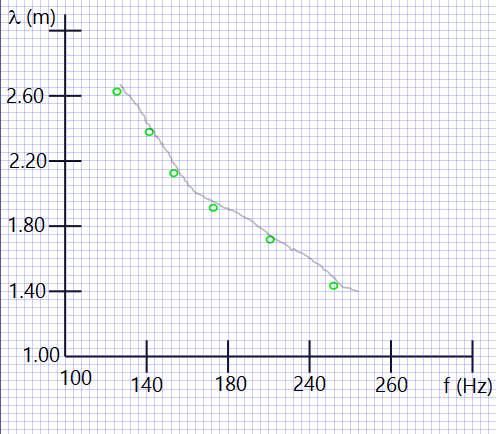
$$
theta = tan{V_{s}}
$$
Where $V_{s}$ is speed of sound.
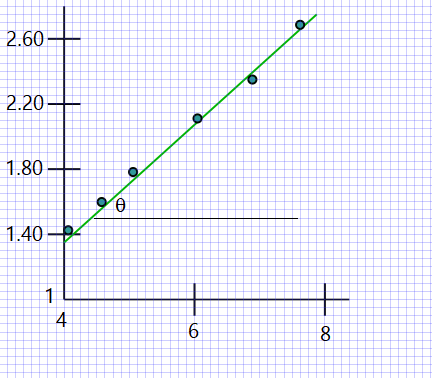
$textit{b.}$, Speed of sound is slope on the graph.
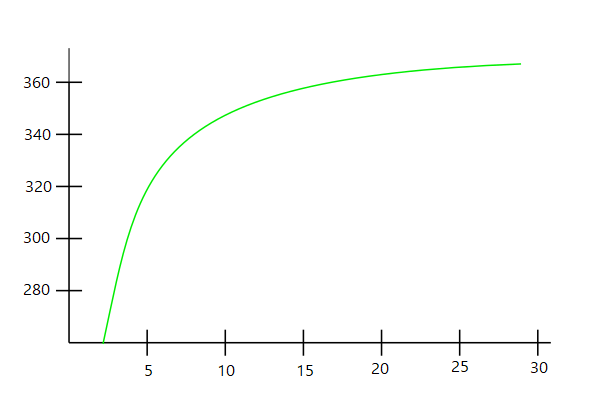
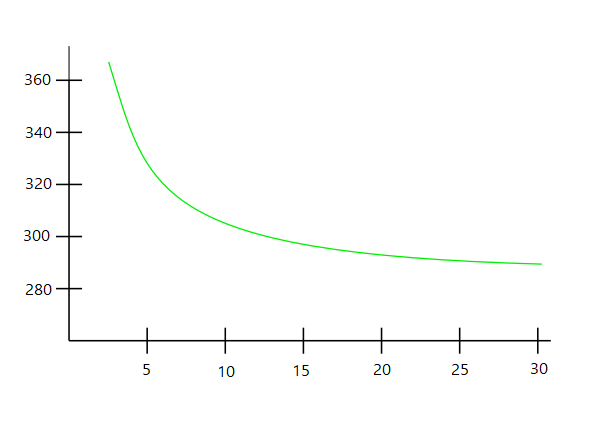
$L = 200, mathrm{m}$
First, we have to measure certain values in order to determine speed of sound, since we have the distance which is $200, mathrm{m}$ we have to measure interval of time in which sound reaches us.
We can do it by starting the measurement the moment we see the hit and stop it when we hear the sound.
All we have to do now is to divide given distance with the time we have just measured which will be large because of the way we have measured, therefore, estimated speed of sound will be too small since the time is large.
First we can determine mass per unit of length $mu$.
What we need to measure in order to determine it are mass of the string and its length and after we can determine tension by putting weights on it which will stretch it and by measuring the amount of stretch we can easily determine it.
Next, we can determine frequency for what we need frequency generator and by using beats we can tune it.
Finally, we can determine speed which equals: $v = lambda f = 2 L f$, where: $L$ is length of the string.
Finally, we can measure frequency by using frequency generator and finally determine speed in the end by using the following formula:
$$
v = f 2 L
$$
2 Neck.
3 Bridge.
4 Sound post and bass bar.
5 Tailpiece.
6 Pegs.
7 Bow.
8 Strings.
$v_{1} = 3, mathrm{m/s}$
$m_{A} = 1, mathrm{kg}$
$m_{B} = 2, mathrm{kg}$
$v_{A2} = 2, mathrm{m/s}$
$v_{B1} = 0$
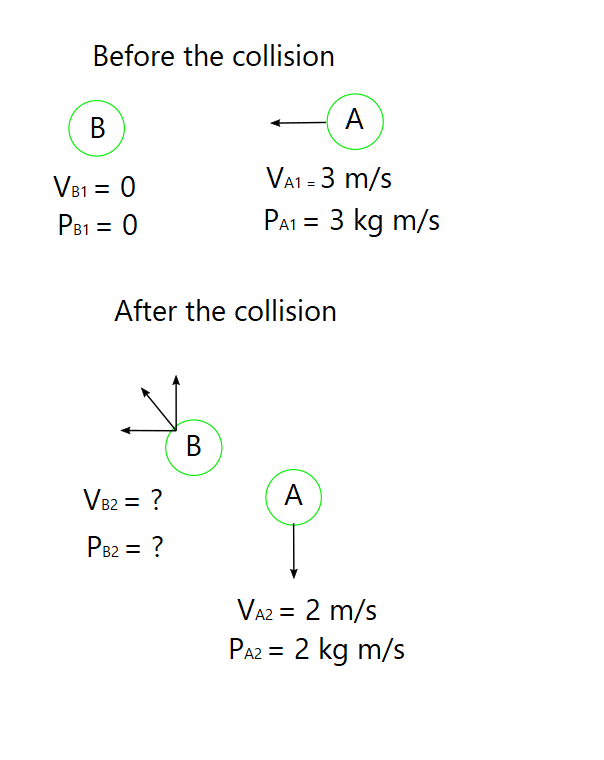
We will be using law of conservation of momentum in horizontal and vertical direction:
In horizontal direction it is:
$$
P_{A1} = P_{B2}
$$
$$
m_{A} V_{A1} = m_{B} V_{B2}
$$
When we put known values into the previous equation we get:
$$
m_{B} V_{B2h} = 3, mathrm{kg m/s}
$$
In vertical direction it is:
$$
P_{A2} + P_{B2} = 0
$$
$$
m_{A} V_{A2} + m_{B} V_{B2} = 0
$$
$$
m_{B}V_{B2v}= – 2, mathrm{kg cdot m/s}
$$
Momentum $P_{B2}$ as intensity of an vector will be given as sum of intensity of vectors:
$$
P_{B2} = sqrt{P_{B2}^{2h} + P_{B2}^{2v}}
$$
$$
P_{B2} = sqrt{(3, mathrm{kg m/s})^{2} + (-2, mathrm{kg m/s)^{2}}}
$$
$$
P_{B2} = 3.6, mathrm{kg m/s}
$$
Therefore $V_{B2}$ will be given as:
$$
V_{B2} = dfrac{P_{B2}}{m_{B}}
$$
$$
V_{B2} = dfrac{3.6, mathrm{kg m/s}}{2, mathrm{kg}}
$$
$$
boxed{V_{B2} = 1.8, mathrm{m/s}}
$$
P_{B2} = 3.6, mathrm{kg m/s}
$$
$$
boxed{V_{B2} = 1.8, mathrm{m/s}}
$$
$h = 22, mathrm{m}$
$a = 3, mathrm{m/s^{2}}$
$Q = mg = 480, mathrm{N}$
$U = ?$
$F = ?$
Energy that the pillow has to absorb is the initial potential energy of the person which is given by:
$$
U = mgh
$$
$$
begin{align*}
U &= 480, mathrm{N} cdot 22, mathrm{m}\
&= boxed{11, mathrm{kJ}}\
end{align*}
$$
And force is simply given by the Newton’s second law:
$$
F = ma = dfrac{Q}{g} a
$$
$$
begin{align*}
F &= dfrac{480, mathrm{N}}{9.81, mathrm{m/s^{2}}} cdot 3, mathrm{m/s^{2}}\
&= boxed{150, mathrm{N}}\
end{align*}
$$
U = 11, mathrm{kJ}
$$
$$
F = 150, mathrm{N}
$$

